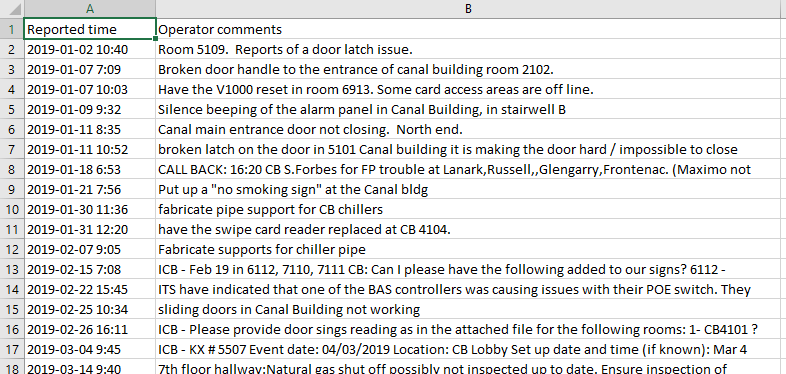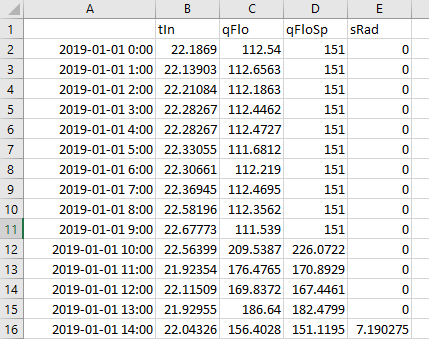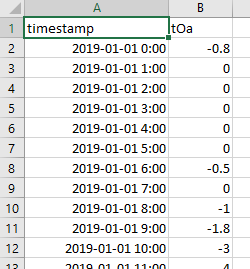Complaint Analytics
The complaint analytics function calculates the frequency of hot/cold-related occupant complaints and the conditions that produce them.
Inputs
Computerized Maintenance and Management System (CMMS)
The complaint analytics function requires CMMS operator work order log data. These data log the building operator's work orders and typically contain comments about complaints made by building occupants. The data must contain the work order's description and the time at which the work order was entered. The data must be formatted as seen in Figure 1.

The first column must contain the timestamp at which the work order was entered, which must include the numerical date and time and in the following format: [yyyy-mm-dd hh-mm]. The second column must contain the work order description.
Only one (1) CSV file containing CMMS operator work order log data must be supplied to this function.
Zone-level HVAC Control Network Trends
The complaint analytics function also requires zone-level HVAC control network trend data. These data are a record of various actuator and sensor measurements pertaining to variable air volume terminals (VAV) which regulate airflow and sometimes re-condition supply air from the AHUs to specific thermal zone(s). For this analysis, four unique trend data are required for each zone/VAV; they are as listed with units and range in Table 1 and must be formatted as seen in Figure 2.
| Required trend data | Abbreviation | Unit | Range |
|---|---|---|---|
| Indoor air temperature | tIn | oC | - |
| Supply airflow | qFlo | m3/s | - |
| Supply airflow setpoint | qFloSp | m3/s | - |
| State of perimeter heating device(s) | sRad | % | 0(inactive) - 100(fully active) |

The first column must contain the timestamp, which must include the numerical date and time and in the following format: [yyyy-mm-dd hh-mm]. Each subsequent column must contain the trend data as listed in Table 1 in descending order (i.e., second column contains indoor air temperature, third column contains supply airflow, etc.)
A minimum of one (1) CSV file containing zone-level HVAC control network trend data must be supplied to this function, where each CSV file represents a unique VAV or thermal zone.
Weather
The complaint analytics function also requires outdoor weather data. These data record the outdoor air temperature within the building's geographic vicinity. The temperatures must be represented in Celsius (oC). The data must be formatted as in Figure 3.

The first column must contain the timestamp, which must include the numerical date and time and in the following format: [yyyy-mm-dd hh-mm]. The second column must contain the measured outdoor air temperature. For this function, measured temperatures must be represented in Celsius (oC).
Only one (1) CSV file containing weather data must be supplied to this function.